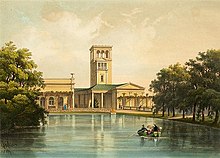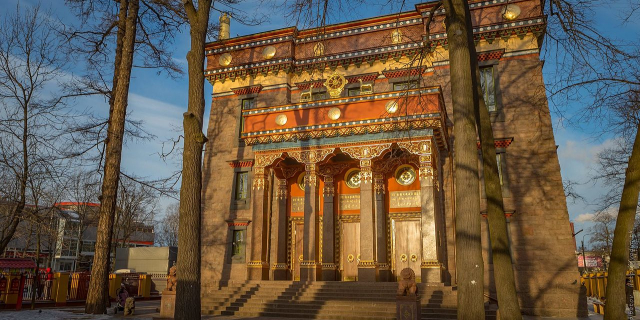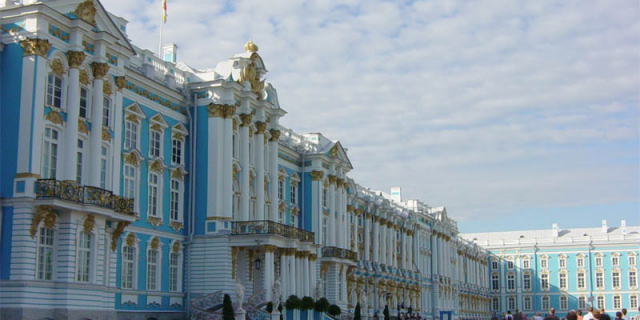Петергоф (дворцово-парковый ансамбль)
( Peterhof Palace )The Peterhof Palace (Russian: Петерго́ф, tr. Petergóf, IPA: [pʲɪtʲɪrˈɡof],) (an emulation of early modern Dutch "Pieterhof", meaning "Pieter's Court"), is a series of palaces and gardens located in Petergof, Saint Petersburg, Russia, commissioned by Peter the Great as a direct response to the Palace of Versailles by Louis XIV of France. Originally intending it in 1709 for country habitation, Peter the Great sought to expand the property as a result of his visit to the French royal court in 1717, inspiring the nickname of "The Russian Versailles". The architect between 1714 and 1728 was Domenico Trezzini, and the style he employed became the foundation for the Petrine Baroque style favored throughout Saint Petersburg. Also in 1714, Jean-Baptiste Alexandre Le Blond, likely chosen due to...Read more
The Peterhof Palace (Russian: Петерго́ф, tr. Petergóf, IPA: [pʲɪtʲɪrˈɡof],) (an emulation of early modern Dutch "Pieterhof", meaning "Pieter's Court"), is a series of palaces and gardens located in Petergof, Saint Petersburg, Russia, commissioned by Peter the Great as a direct response to the Palace of Versailles by Louis XIV of France. Originally intending it in 1709 for country habitation, Peter the Great sought to expand the property as a result of his visit to the French royal court in 1717, inspiring the nickname of "The Russian Versailles". The architect between 1714 and 1728 was Domenico Trezzini, and the style he employed became the foundation for the Petrine Baroque style favored throughout Saint Petersburg. Also in 1714, Jean-Baptiste Alexandre Le Blond, likely chosen due to his previous collaborations with Versailles landscaper André Le Nôtre, designed the gardens. Francesco Bartolomeo Rastrelli completed an expansion from 1747 to 1756 for Elizabeth of Russia. The palace-ensemble along with the city center is recognized as a UNESCO World Heritage Site.
 The Ozerki Pavilion (1840s), by Yegor Meyer
The Ozerki Pavilion (1840s), by Yegor MeyerIn the early 1700s, the original Peterhof appeared quite different from today. Many of the fountains had not yet been installed and the entire Alexandrine Park and Upper Gardens did not exist. What is now the Upper Gardens was used to grow vegetables, and its ponds, then numbering only three, for fish. The Samson Fountain and its massive pedestal had not yet been installed in the Sea Channel, and the channel itself was used as a grand marine entrance into the complex.
 Olgin Pond (1840s), by Yegor Meyer
Olgin Pond (1840s), by Yegor MeyerPerhaps the most important change augmenting Peter's design was the elevation of the Grand Palace to central status and prominence. The Grand Palace was originally called simply 'Upper', and was hardly larger than any of the other structures of the complex. The addition of wings, undertaken between 1745 and 1755, was one of the many projects commissioned from the Italian architect Bartolomeo Rastrelli by Elizabeth of Russia.[1] Likewise, the Grand Cascade was more sparsely decorated when initially built.
1941–modern dayPeterhof, like Tsarskoye Selo, was captured by German troops in 1941 and held until 1944. In the few months that elapsed between the German invasion of the Soviet Union and the appearance of the German Army, employees were only able to save a portion of the treasures of the palaces and fountains. An attempt was made to dismantle and bury the fountain sculptures, but three quarters, including all of the largest ones, remained in place.
 Monument of the naval landing in Lower Gardens of Peterhof near the pier.
Monument of the naval landing in Lower Gardens of Peterhof near the pier.On 23 September 1941 German troops captured Peterhof. Two weeks later, on 5 October 1941, Soviet troops tried to recapture the town and block the highway by naval landing. 510 marines of the Soviet Baltic Fleet landed on the beach of the neighboring park of Alexandria but faced a heavy fire from the Germans. The commander of the operation was killed, all landing troops became disorganised, one landing craft was sunk and another one missed. Despite Soviet attempts to cover the landing forces by coastal artillery from Kronstadt, they were quickly suspended because of lack of connection with the landing troops. Evacuation attempts also failed due to heavy German artillery shelling (only one marine was picked up from the water). The Peterhof landing operation failed and all landing troops were cut off from the shore and surrounded. Some of them reached the Lower Gardens and fought until the bitter end, including hand-to-hand combat. The last pockets of resistance were destroyed on 7 October. Several dozen German Shepherd dogs were released into the gardens to find the hiding marines. Many of the wounded marines were mauled to death and several were captured.[2]
The occupying forces of the German Army largely destroyed[3] Peterhof. Many of the fountains were destroyed, and the palace was partially exploded and left to burn. Restoration work began almost immediately after the end of the war and continues to this day. The Lower Park was reopened to the public in 1945.[4]
The name was changed to "Petrodvorets" ("Peter's Palace") in 1944 as a result of wartime anti-German sentiment and propaganda, but the original name was restored in 1997 by the post-Soviet government of Russia.
The "purpose" of Peterhof was as a celebration and claim to access to the Baltic (while simultaneously, Peter the Great was also expanding on the Black Sea littoral).
































Add new comment